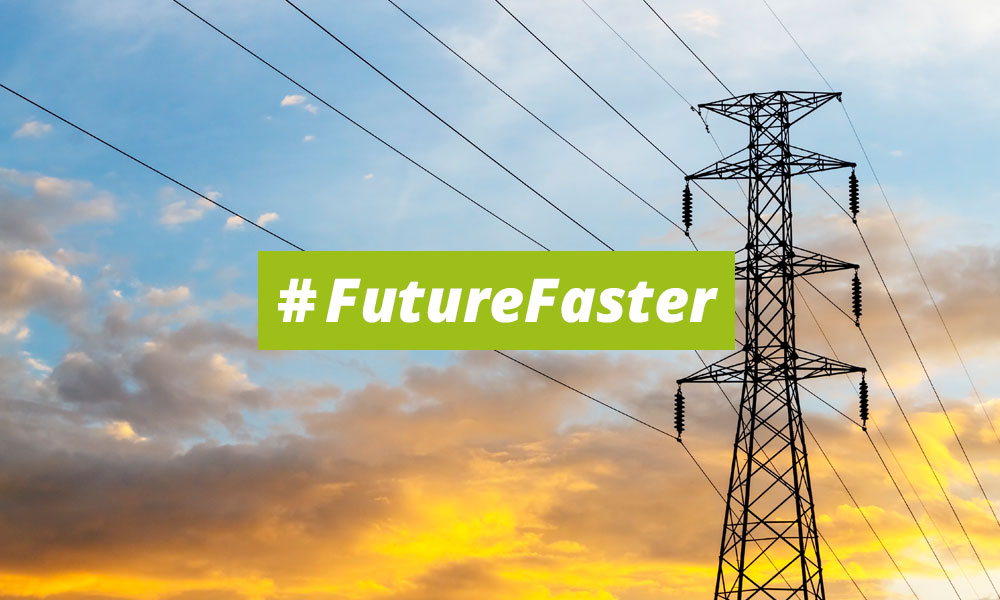Zero-carbon grids are set to power the #FutureFaster
Nigel Topping, CEO of the We Mean Business coalition
“There is no technical or economic barrier to transitioning the entire world to 100 percent clean, renewable energy with a stable electric grid at low cost”.
That’s the conclusion of Mark Z. Jacobson, a professor of civil and environmental engineering at Stanford University, who led a recent study in the rollout of renewable energy. It may not seem like a radical idea, however it’s a view that even just a few years ago did not seem plausible and today is being proven on a daily basis.
Thanks to the rapid decline in the cost of producing renewable electricity, coupled with technological advances in the way power grids are operated, zero-carbon grids are becoming a reality and are set to power the #FutureFaster.
Research by the Energy Transitions Commission (ETC) shows that by as early as 2035, it will be feasible in many geographies to build a near-total renewable power system. This is due to both the falling cost of renewable energy production, and the rapid cost reductions now being achieved in technologies such as battery storage. Such competitiveness could be improved further if a wider set of flexibility options, including demand management and better grid integration were deployed, the ETC adds.
Companies are helping to deliver these improvements in grid technologies that will usher in the era of zero-carbon power systems. For example, Siemens is supplying the transformers for a record-breaking high-voltage, direct current line in China, with a length of 3,284 kilometers and a transmission capacity of 12 GW.
Tesla is working with PG&E on a massive 1.1 GWh battery system in California, after the company’s founder Elon Musk famously won his bet to install the world’s biggest battery in South Australia within 100 days. In systems around the world, digitization and ‘virtual power plant’ technologies are helping to unlock ever greater efficiencies.
Various trail-blazing countries are seizing these opportunities and committing to zero-carbon grids within ambitious timeframes. One of the most striking is Costa Rica, which is aiming for carbon-neutrality across its entire economy by 2021 and is already covering all its electricity requirements with 99 percent renewable energy.
Other countries are aggressively ramping up their commitment to renewable power, such as India, which has increased its 2022 renewable energy target by 28 percent to 227 GW, from 175 GW previously. India is now on track to over-achieve its target of 40 percent non-fossil-based power capacity by 2030, including hydro.
The Climate Vulnerable Forum, consisting of more than 30 member countries including Fiji, Colombia and the Democratic Republic of Congo, recently announced their bold vision to achieve 100% domestic renewable energy production as rapidly as possible.
Just last month, California committed to 100 percent zero-carbon electricity by 2045. And over 65 cities in the US, including San Francisco and Atlanta, have committed to 100 percent renewable electricity, with at least six having already successfully switched.
Business backing
One of the key reasons countries, regions and cities are able to push for zero-carbon grids is because they have the backing of leading businesses, who are demanding cleaner energy.
Over 220 influential businesses have already committed to 100 percent renewable electricity, including over 140 companies through the global RE100 initiative, led by The Climate Group in partnership with CDP.
RE100 members, such as global drinks maker Anheuser-Busch InBev, the world’s largest company by market cap, Apple and the world’s largest company by revenue, Walmart, are now creating demand for 180 TWh of renewable electricity annually — more than enough to power New York state. By the end of 2016, 25 of these companies had already reached 100% renewable electricity.
This shift in power demand towards zero-carbon sources is being met by forward-looking power utilities around the world, which are increasing their renewable energy capacity and rapidly decarbonizing the power system.
Eight power companies, including NRG in the US, Portugal’s EDP and Enel in Italy, already have approved science-based targets to reduce their emissions in line with the ambitions of the Paris Agreement, while 11 others have committed to do so, such as China Light and Power.
Last year Spain’s Iberdrola confirmed it would complete the process of phasing out all its coal-fired power generation capacity worldwide. The company has now become a global leader in onshore wind while bringing down its emissions to 70% below its European peers.
Ørsted, the largest utility in Denmark formerly known as Dong Energy (short for Danish Oil and Natural Gas), transformed its entire business model to become a clean energy company — shifting its supply from coal and oil to clean sources like wind. In Denmark alone, Ørsted accounts for more than half of the entire country’s CO2 reduction since 2006 – helping the country to achieve its Paris commitments.
Meanwhile, the European power utility industry body, Eurelectric, committed to making the region’s power generation carbon neutral “well before 2050”, with the heads of three major energy companies – Italy’s Enel, Sweden’s Vattenfall and Britain’s SSE – outlining the long-term decarbonization vision in Brussels.
This bold action from governments and businesses alike shows that not only are zero-carbon power grids feasible in theory, but they are rapidly becoming a reality, transforming the energy system and helping to build a better #FutureFaster.

